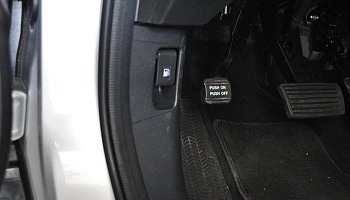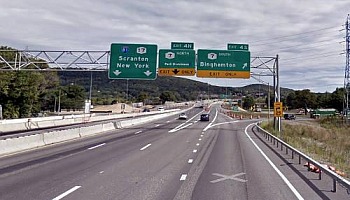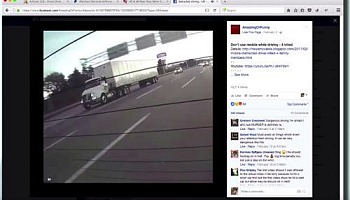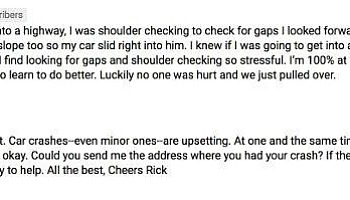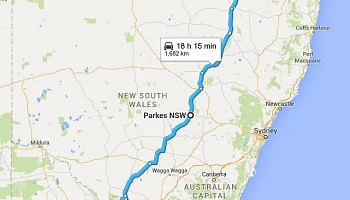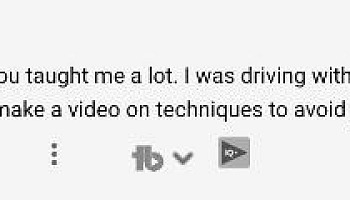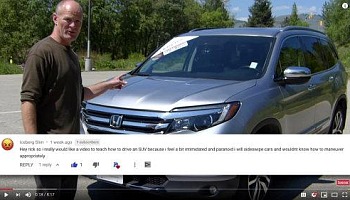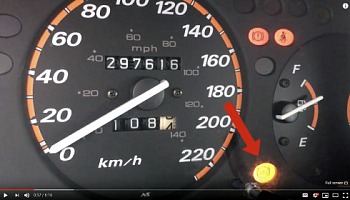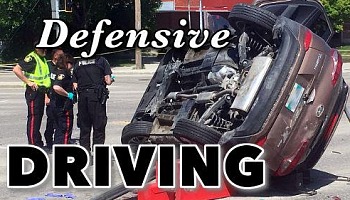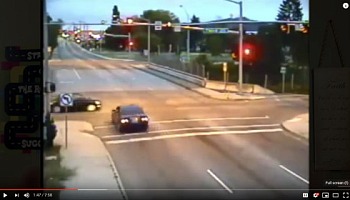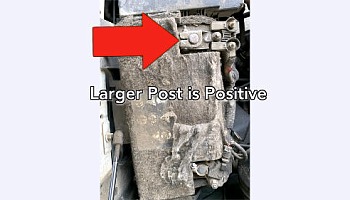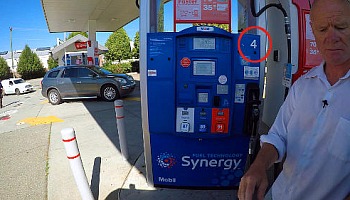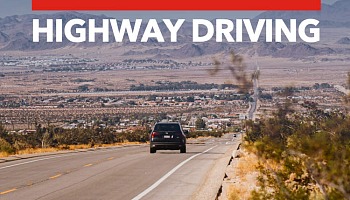Skills & strategies to drive safely in the dark.
How to Drive at Night | New Driver Smart
Closed Caption
Updated May 2022
Introduction
Hi there smart drivers, Rick with smart drive test talking to you today about night driving.
I had a comment from Rosas, she was having some challenges with night driving and asked me to make a video pointing out some of the techniques and tips for helping her to drive at night and in inclement weather.
And actually the same techniques and tips that apply tonight driving can also be applied for inclement weather.
The first thing I'll tell you: turn down the dash lights the lowest setting that you can tolerate, especially as you move away from urban areas.
We will give you some more detail about that.
As well, as you move out of the urban areas into highways and on roads that have less street lighting, you're going to rely more and more on your headlights.
As you rely more and more on your headlights, reduce your speed below the posted speed limit by 5 to 10 kilometers an hour or five to eight miles per hour depending on where you are.
So as you get into darker and darker areas you're going to rely more and more on your headlights.
Road markings are not going to help you find the roadway at night; however street signs will because most of the street with signs are located along roadways and are reflective.
So they will help you to find and locate the roadway.
As well, utility poles are often quite good and often you can see a silhouette of the landscape and geography that will give you some indication of where the roadway is.
And finally houses along roadways with lights on will also help you to locate roadways.
And the most important feature to help you find the roadway at night is other traffic.
Other traffic--for the most part--drives on the roadway, so you can follow the other traffic and look farther down the road and see where the roadway goes.
So what we're going to do today, we're going to some more detail about all of that and go for a drive and give you an in-depth detail of how to find the roadway.
Stick around we'll be right back with that information.
Lower Your Dash Lights
Hi there smart drivers, welcome back.
Rick with smart drive test sitting in the dark in my car.
We're gonna go for a drive here and I'm going to give you some information about night driving and how to make that easier and safer.
Now just before we get going here, the first thing I'm going to tell you:
Turn down the dash lights in your vehicle to the lowest setting that you can tolerate
Because I've seen these new vehicles and the dash is so lit up it looks like a fireworks celebration.
So turn your lights down, because what happens is that our eyes are attracted to light and movement.
And therefore because your dash lights are so bright, it's going to pull your vision down towards the dash, when actually what you want to do is look farther down the road and try and find the features on the road they're going to help you to locate the roadway.
[FLASHES OF LIGHT ON-SCREEN THAT MOVE THE VIEWERS EYES TO UNDERSCORE POINT]
Light & Movement
As well, because your eyes are always being drawn down to that bright light on the dash, you're going to fatigue easier and it's going to erode your night vision.
You need to protect your night vision; so turn your dash lights down to as low as you can.
Now I've been driving for a long time and driving professional - trucks, buses and whatnot and I have my dash lights down to the minimum setting and you can barely see the dash.
And actually, on some of the professional vehicles--buses and trucks--you can actually turn them down until they’re almost off.
If you're running on cruise control out on the highway at night - yes turn them down, so they're almost off.
Because you're on cruise anyway, and you're at a set speed.
And you really don't need to see the gauges on the dash if you're running the same vehicle all the time, and running for long periods of time.
You're going to know if something's wrong that vehicle - you really don't need to monitor the gauges at night.
So turn your dash lights down.
I can't stress that enough because it erodes your night vision.
So we're gonna fire up the cameras, go for a drive.
Utility Poles
I'm on a back alley here - you can see the utility poles (utility poles) if you look up into the sky.
You can actually see the utility pole, so I can actually see here a fair distance.
I can probably see an eighth of a mile here or 3- 400 meters because of the utility poles.
As well, it also helps that i do know the roadway.
Now I've got my cabin light on in the vehicle because otherwise the camera that's pointed on me, you can't see me without that cabin light on.
So we're going to start off in an urban area and urban areas are quite easy to drive in at night because they're well lit because of the streetlights.
Street Lights
You can see the streetlights here in the dash cam.
And they're all in a row and they mark out very nicely the roadway.
The road markings are not so clear because they get repainted in the summertime and by the time we head into winter, they become faded.
So the road markings are not a great indicator of where the road is going to go.
Now road signs on the other hand, are reflective and because these are reflective road signs are good indicators of where the road is going to go - in which direction the road is going to go.
So we're going to start out in a dense urban area here and it's well lit - lots of streetlights, traffic lights reflective signs, clear road markings.
Pedestrian Traffic
And we can see the pedestrian here running, and I know that this sidewalk runs out and there's a good chance because there's a crosswalk here that pedestrian is going to come across and I can just see the reflective markings on the back of the pedestrians shoes.
And I also know down the road here there is a gym and he is probably--he or she--is probably going to the gym.
So they're running along the edge of the road - so there's little danger here.
Fog Lines
Now the roadway is fairly clear - there's a fog line on the outer outer edge of the roadway and in this day and age all roadways--most roadways--unless you get in some remote backcountry, are all going to have fog lines and the fog line is the line that runs down the outer edge of the road.
Most roads are going to have fog lines, which will help you navigate at night.
For us who drive on the right side of the road, it's going to be on the right side of the road and for those in the U.K.
(United Kingdom) in Australia, it's going to be on the left side of the road.
Follow Other Traffic
In many cases, it's going to be reflective.
So it's easy to find.
Now the other indicator and the most important indicator of driving at night is other traffic.
And I can see up here, if I look down the road I can see the other traffic deviating to the right.
So I know that the road goes to the right even though there aren't any signs indicating which way the roadway goes, I know it's going to the right because the other traffic is going to the right.
Mirror, signal, shoulder check to the left - three flashes on the signal.
Rear View Mirror Switch
There is a vehicle behind me, but I can move over now because there's enough space.
The other technique - if you get vehicles behind you that have their high beams on and forget the lower their high beams is there's a little switch on the bottom of the mirror here.
There's a toggle switch on the bottom of the center mirror that will change the angle to prevent glare from vehicle to the rear.
You can tilt that so that you don't get that reflective glare in your eyes.
And again that reflective glare in your eyes is going to erode your night vision.
We need to protect our night vision.
So at night you can turn this down and it won't reflect the light from the vehicles behind you into your eyes.
Crosswalks
And again we're in the urban area and it is clearly marked with the streetlights and I can see the line of streetlights going all the way up here.
As well I can see a traffic light and I know that the roadway goes straight because of that traffic light.
And in British Columbia, Canada we have these flashing traffic lights, which are pedestrian activated traffic lights - so be looking for pedestrians.
As well, there's a crosswalk here at the hospital.
I'm looking on both sides for pedestrians.
And again, it's important that you scan the crosswalks to look for pedestrians because all too often at night pedestrians are not wearing reflective clothing.
They're wearing dark clothing and they are difficult to locate at night because of our loss of vision.
Even with our night vision--if you are well adapted to the night--our night vision in the city is going to be eroded because of streetlights and other lighting that undermines and the erodes our night vision.
We have reflective signs at night - we're looking for the reflective signs.
And this roadway again, I'm watching the traffic and the traffic is veering off to the right here.
And I know that the roadway goes around to the right and I can see the traffic over to the right and then it comes back to the left.
So at night when you're driving use the other traffic as an indicator.
If there's traffic on the roadway, stay back and follow the other traffic.
Because the other traffic obviously is [CHUCKLING] going to drive on the roadway.
So simply follow the other traffic.
Now what we're going to do is we're going to drive up here and there is a roadway to the left that is dark and there aren't any streetlights on it.
So i'm going to use that to try and give you some help with driving on dark highways at night that have very little lighting and have very few road markings or reflective signs.
And try to point out some of the markers that you can use to locate and find the roadway.
And again, you want to maintain a really good space between you and other vehicles in front of you at night.
Losing Control
That way you have a good buffer of space so that you can react moderately without having aggressive use of the primary controls.
Because aggressive use of primary controls--oversteering, over-braking, and over-acceleration--are going to cause you to lose control of the vehicle.
So I'm on the highway here now and it's 50mph and you want to put the vehicle on cruise and stay in the right lane.
And it's often best to run a few miles less—3-5 miles an hour less if you're in the United States—less than what the speed limit is or the traffic flow - whatever you're comfortable with.
That way you've got a good buffer of space and you're going to maintain a buffer between yourself and other vehicles on the roadway.
And again, I got streetlights up here at the intersection.
And actually I'm going to turn up here.
So I'm moving over to the left: signaling, to the left, and there's a turning lane here.
And i'm going to get into that turning lane as soon as possible.
And I'm looking as far down the road as I can see for traffic coming.
There isn't any coming, so I'm just going to turn onto this dark road.
Now obviously I am going to go slow.
Dark Road at Night
I'm not going to go very fast.
Because I know this roadway and it's curvy and it's dark and it's not well lit.
Now I can see that this roadway...
The road goes around to the right.
There's a vehicle sitting there and I can see there are two road signs there.
And those two road signs are...
All road signs are almost always along the edge of roadways.
Now I got another vehicle coming here and because of that vehicle its told me that the road goes around to the left.
So obviously that vehicle is on the roadway.
The road goes around to the right.
And I'm driving at 50 kilometers an hour - 30 miles an hour.
I'm not driving very fast because this roadway is dark, and of course it's a little bit harder for me to see the road because I have the cabin light on.
I'm just going to turn the cabin light off for a moment here and it'll make it a little bit easier for me to see in the dark because that cabin light, believe it or not, is eroding my night vision.
Roadway Features (Markers for Drivers)
Now I can tell because of the top of the mountain here, I can see that the roadway goes around the left here.
And the roadway goes around to the right.
Again there is a curve sign on my right side here.
You probably can't see this very well in the dash cam because it is very dark here.
Now I'm going to turn on my bright lights right now.
So those are my bright lights and they light up the road a lot better than my low beams.
Whenever possible at night, if there's not other traffic coming, use your bright lights.
Now I have a good indicator here because there is a traffic sign on the right side here.
And I know the roadway is now going to go to the left because I can see the mountain curving around to the left.
So that is my indicator on this dark road that the road is now going around to the left.
And I'm trying to look as far down the road as I can and again I'm not going very fast.
If you're not comfortable going faster on a dark road at night, don't go faster than what you're comfortable with.
And you can see as well on this roadway there isn't a fog line on this road.
Right now I have some lights on the left here and I have a house on the right up on the hill.
So I know that the roadway goes to the left and again I can see far enough down here - I've got a road sign down here.
Now I know that the road curves around the left.
And I can just make out a faint outline of the geography, and I know that the roadway now goes around to the right again.
And I've got another light on the left on one of the driveways to the houses down on the embankment of the to the lake.
And again I've got some lights on the left.
Again so I know that the roadway goes around and curves to the right.
And as well it makes it much easier now that I have my high beams on--my brights.
There isn't any other traffic on the roadway, so it's safe for me to keep my high beams on because I'm not going to blind other traffic.
And again I know the roadway goes around to the left.
I can see the centerline and I can see there's lights up here on the left that tell me that the roadway now goes around to the right.
And again I've got a utility pole here and I've got a sign on the left.
And another utility pole - utility poles actually make it quite easy now because I can see 200 yards because of the utility poles.
Now I got two signs here - one on either side that tell me that the road goes around to the right which makes it very easy for me to follow the road.
And again I can see up here on the curve that the road goes around to the left.
So if you're looking farther down the road it's easy to anticipate the direction that the roadway goes.
nd again, I've got my brights on, but I'm going to turn my brights back off because I'm coming up to the highway here.
And again it's much much more difficult to see with your low beams on at night on a dark road.
So I'm going to slow down here.
Now I want that lane over there and you saw there that that was a bit difficult for me to see coming around that corner for the appropriate lane to be in.
And I've got lots of traffic on my left...
I'm back out on the main highway here and it's much easier to be back on the main highway because now I can just follow the other traffic and I know exactly where the roadway goes.
So the traffic is going around to the right and I just follow them around to the right.
And I don't need my high beams on.
As well you can see all the reflective markers on the center median here in the roadway.
And I've got the fog line on the right side of the road.
So I know where my lane is and I just look down the road and I follow the other traffic.
And they're all going around the left now.
So I just deviate around to the left.
I've got a road sign on the right that's telling me to pass the objects on the left.
Object Marker Signs
And those object markers - there's another video here on the channel you can check out those and find object markers.
Once you see those object markers you'll see them absolutely everywhere on the roadway.
They're probably the most prolific signs on our highways and roadways.
And they warn you of hazards and obstructions that you could potentially strike.
And again, I'm following the traffic around to the right.
And again I can see the line of reflective markers on the center median in the roadway.
And those make it very easy for drivers to delineate where the roadway is.
Signs on the right.
Again, another object marker and reflective markers on the top of the concrete barrier on the right side of the roadway.
And again, I can see the traffic, and I can see which direction it's going.
And I'm coming up here to the intersection and I'm slowing down because I'm going to make the right here.
Another Dark & Desparate Road
And again go onto a dark road and give you some indication of how to drive on dark roads at night.
Because roadways that have traffic and plenty of traffic lights and plenty of signs are much easier to drive on as opposed to these dark dark roadways.
And there's a car on the side of the road which I didn't see until I was almost on top of it.
And again there aren't any fog lines on this roadway and I've got a road sign there that tells me that the road actually curves around to the left.
And it's more important at night that you pay attention to the road signs because the road signs will give you an indication of which direction the roadway goes, and they will give you information about which way the roadway goes.
Often in the form of a curve sign or intersections ahead.
You especially want to know if you're coming up towards the intersection at night because you want to scan the intersection well and ensure that there aren't other vehicles or road users.
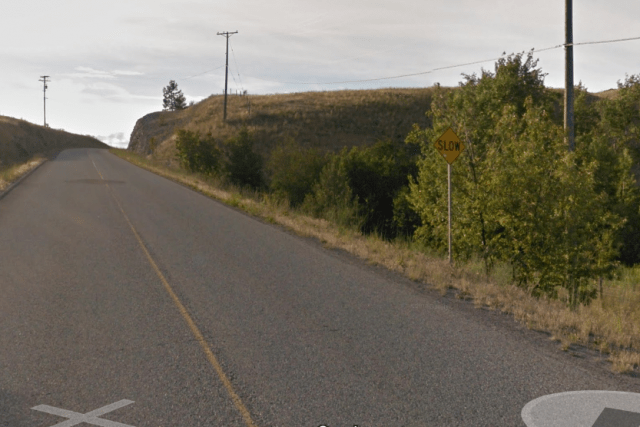 Now I've got a slow sign here on the right and I know from the geography in front of me that the road curves around to the right side.
Now I've got a slow sign here on the right and I know from the geography in front of me that the road curves around to the right side.
So I just follow the road around.
Again I'm not going very fast.
I'm doing about 40 miles an hour just a little over 60 kilometers an hour.
And I am comfortable with that on this road.
It's a fairly wide two-lane skinny - two lanes traveling in either direction.
Locating Intersections
Now I've got traffic going perpendicular to my roadway up here, so it indicates that there's an intersection up there.
As soon as I saw that traffic, I knew I was coming up to an intersection.
And right now you could probably see in the dashcam, the "STOP" sign ahead.
And I've got other signs here which indicate the intersection, and I've got a object marker that tells drivers to go right or left.
So I'm going to go right because I'm going to go back into Vernon, British Columbia, Canada.
I've got three signs up here and you can probably see all three of those signs in the dash cam which tell me which way the roadway goes.
This last sign is a curve sign, which tells me the roadway go to the left and then it comes back to the right - it does a little zigzag.
I've got another road sign on the other side - it's reflective markers on the top of the concrete medium which told me where the roadway was.
On the left we've got another curve sign to the left and I can also see the outline of the topography-- the geography here--that tells me it goes around to the left.
Now I've got another curve sign that tells me the roadway goes to the right.
You can see on this roadway there isn't a fog line, which doesn't help too much.
This is a pretty sharp curve so I apply the brake the little bit - I applied the brake a little bit and again the roadway goes around the left.
I've got a couple little reflective markers there on the shoulder of the road - actually those are pylons with reflective tape.
I reduce my lights to low and I look down to the edge of the road with those other cars going by because I'm trying to preserve my night vision.
Protect Your Night Vision
Because if I stare into that light and I get dazzled, as they say in the U.K., it's going to erode my night vision.
And it takes time for your night vision to recover, especially the older you get, the longer it takes for your night vision to recover.
As soon as that vehicle goes by I look down the road, I don't see any vehicle.
I see a vehicle - the taillights of the vehicle quite a distance up there...probably three-quarters of a mile; a kilometer up the road.
And that tells me that the roadway is fairly straight from here to there, because I could still see that vehicle.
And again I have utility poles along the right side of the road.
I have reflective tape or some sort of reflective material on the utility poles and that indicates the direction of the roadways.
I've got another road sign up here, so I can see for a good half a kilometer - far beyond my headlights where the roadway goes.
Animals on the Road
Now that doesn't mean that there aren't animals on the roadway.
And you need to be on the look out for animals on the roadways, especially if there are signs warning you that there are deer, or wombats, or Tasmanian Devils.
Tasmanian devils are real.
They live in Tasmania, oddly enough.
They're not just on Disney films [CHUCKLING]...or Looney Tunes, not Disney.
Sorry about that.
 So we've got a squiggly line up here and I can see the reflective markers that tell me the roadway goes around to the left.
So we've got a squiggly line up here and I can see the reflective markers that tell me the roadway goes around to the left.
And again I'm only doing about 75 kilometers about 45 miles an hour.
And again the roadway goes around to the right even though there's no sign here.
Because I can see the geography along the edge of the road because I have my bright lights o.nAand again, the roadway goes to the left.
And I can see reflective...two faint reflectors on either side of the road which tells me that the roadway goes straight between the two markers.
And there's a utility pole directly in front of me which tells me that the road is going to deviate to the right here.
And I can also see that...oh I thought there was a car coming so I lowered my lights.
If you're unsure, err on the side of caution and lower your brights too low beams.
It's really a courtesy to other vehicles.
Now the road narrows here.
I have a sign on my right.
I've got another road sign down farther, which tells me that the road is going straight.
Now i can see that the roadway is going to curve to the right here because I can see two vehicles quite a distance down the road here.
Road Features that Mark the Way
But it's going to deviate to the right farther down here.
Now I've got a car coming here with his brights on.
I'm going to turn mine down and it is a little bit distracting with those bright light because as I said, our eyes are attracted to light and movement.
And at night it is more pronounced how our eyes are going to be attracted to that light.
Now that light is blinding a little bit and I just look down at the edge of the road - the outside edge of the road and that will help me to maintain my night vision and maintain control of my vehicle.
As well, you can take your foot off the accelerator and slow down a little bit.
That too will help you maintain control of your vehicle.
Now a lot of these techniques of looking for road signs and looking for utility poles along the roadway are going to be the same techniques that you're going to implement in inclement weather - in fog, and rain, and snow, and ice and and other times that you have poor visibility or reduced lighting conditions.
Now I've got another car here, about a half kilometer - quarter of a mile and I reduce my high beams as soon as I can.
And now it's getting a little easier, because I'm getting into town.
Now the roadway has a fog line on it, so it's much easier to see.
I've got more buildings along the right side of the roadway here, and there are lights on in the buildings.
And those lights on the buildings again are indicators of where the road goes.
So I've got another sign on the left side of the road here.
I turn my high beams back on.
And these aren't necessarily reflective signs.
These are obviously some sort of utility markers that they've put along the roadway, but yet those will give you a rough idea where the roadway goes.
Now the roadway has gotten a bit wider - there's a fog line & a center line.
There's more signs along the roadway and I'm actually able to increase my speed now because there are more signs and there are more houses and it's easier to locate the roadway.
So with more signs and more lights and more houses and buildings in built-up areas, you're going to be able to increase your speed.
But as visibility reduces, as the conditions deteriorate, if you're in fog or snow or those types of things or it's just dark and the roadways narrows and there aren't good fog lines, you want to reduce your speed.
Urban Night Driving
Because the darker it becomes and the less features there are to locate the roadway the more and more you're going to have to rely on your headlights.
And the more you rely on your headlights, you don't want to be screaming down the road.
And as you can see here we're coming back into town and there's a pedestrian crosswalk here.
And there are street lights over the pedestrian crosswalk to try and increase safety for pedestrians crossing the roadway.
And here in Vernon, BC, Canada there's a military base.
In the summertime the military base is quite active.
We have all the military cadets from all over Canada that come here in the summer time to train.
And again, as you can see here we're moving into the urban area.
The roadway is becoming much easier to see and we are able to rely less and less on our actual headlights to find the roadway.
And now we're right into a suburban area and there's lots of signs along the roadway that indicate where the roadway goes and where you need to steer your vehicle.
Conclusion
Quick review of night driving.
Turn your dash lights down as much as you can tolerate them down.
It's going to make it easier on your eyes and it's going to preserve your night vision.
As well, the switch on the mirror - make sure you turn that, especially for vehicles behind you that are shining their lights up through the back window.
That too will reduce the glare that comes off that mirror and shines into your eyes.
Again this is going to preserve your night vision and make you less fatigued through the night.
If you are driving through the night...
say sort of ten o'clock at night till the early hours of the morning 6am and whatnot, I'll put a video up here for you in the corner on fatigue management, and some of the techniques that you can implement to stay awake in the middle of the night if you're driving long hours through the night.
As well, that is also important.
And look for any features along the roadway that are going to help you navigate and determine which way the road is going to go.
Whether that's the outline of geographical features, signs along the roadway, or houses with lights on inside, especially as you get farther out into the country.
It's going to be more difficult to determine where the road goes and as it becomes more difficult to determine where the road goes because there are less features that are going to indicate which way it's going you need to rely more and more on your headlights.
As you rely more and more on your headlights, you're going to have to reduce your speed, oftentimes maybe five to eight kilometers less than the posted speed limit (5-10mph).
And as conditions deteriorate anyway, you're going to reduce your speed that you're traveling.
As well, when you're on main highways and those sorts of things, often times the traffic itself will tell you the direction of the road.
And you can simply look at other traffic.
Many features on the roadway are reflective: the signs are reflective; there are reflective markers in the middle of the roadway that divide the roadway.
And all these things will aid you to find out the roadway and to navigate down the road safely in the dark.
Night driving - reduce your speed and watch far down the road.
Watch other traffic and look for any features that will tell you where the roadway is going.
Question for my smart drivers:
Do you have any tips for new drivers learning to drive at night and help them to navigate better through the darkness?
Leave a comment down in the comment section there - all that helps us out.
Salutations
I'm Rick with Smart Drive Test, thanks very much for watching.
If you like what you see here share, subscribe, leave a comment down in the comment section.
As well, hit that thumbs up button.
Check out all the videos here on the channe if you're working towards a license or starting your career as a truck or bus driver.
As well, head over to my website - lots of great information over there and online courses that you can purchase.
Stick around to the end of the video, there's links for more videos and great information.
Thanks again for watching.
Good luck on your road test.
And remember, pick the best answer not necessarily the right answer.
Have a good night.
Bye now.
Blooper
There we go! Much better! Distracted driving - I'm distracted driving because I'm fiddling with my camera at the traffic light.
[LAUGHING] We probably won't put that in the video!

